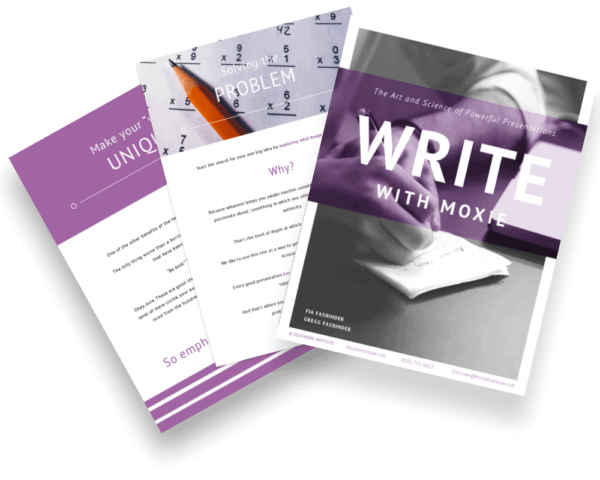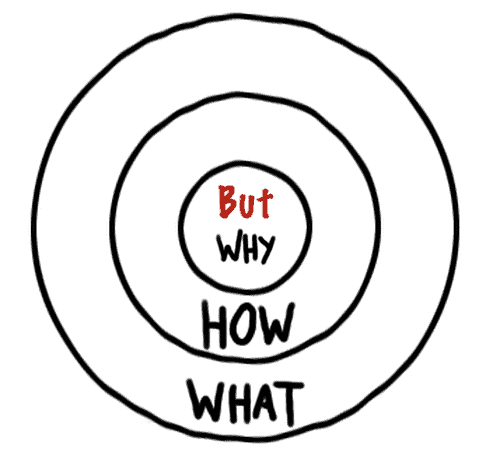Welcome to the end of writer’s block and uninspiring presentations and say hello to Moxie Institute’s POWER Method. From now on you’ll have a framework and process to follow to ensure that the foundation to your speech, a.k.a. “your content” is as strong as it can be.
When putting together your presentation, write from the seats, not from the stage.

We know that sounds easy, but in practice, it’s one of the most difficult elements to writing a speech.
Actors learn the importance of audience-centric performance early in their training. It’s not enough to inhabit a character on stage and express the emotions of this imagined person. Acting requires constant attention to the needs of the audience while adopting that persona: where to stand, how to work with the lighting, how to project one’s voice. How to give your portrayal of those emotions enough of a push to be seen from the back of the house.
As it turns out, public speaking is no different.
It requires a performance from the speaker and a performance that’s attentive to the needs of those listening.
Table of Contents
ToggleWRITE WITH POWER – THE POWER METHOD
The term POWER is an acronym for presentation writing and over the course of this series we will dive deep into each letter:
- P – Purpose – How to write with purpose. No one has ever heard a speech and said, “that was great, but what was the speaker’s point?”
- O – Organize – We will teach you how to organize your thoughts and how to write the outline for a speech.
- W – Writing tips and techniques are the best tools at the disposal of any good presenter. We will cover how to harness the power of the pen.
- E – Engaging your audience is of the utmost importance, if your audience is not engaged in your words and delivery, it’s going to be an uphill battle.
- R – Revise – Even Michael Jordan wasn’t good at basketball to begin with. He was cut from his high school team. As much as it is painful, we learn our best life lessons when we are challenged. No one starts out on top, the greats are the ones who stick around until the end. It’s been hypothesized that it takes roughly 10,000 hours of practice to master a skill.
HOW TO WRITE A SPEECH – WHAT IS YOUR PURPOSE?
Below we will dive deep into the first letter of POWER – “P” and help you find the Purpose of your presentation or speech. The 3 Lessons to find your Purpose are:
- Audience Analysis
- Find the Message
- How to Brainstorm your Talk
Audience Analysis
Audience Analysis is one of the key components in any good speech. If you don’t know who you’re writing for, then you’re likely writing for an audience of one –– yourself. Through our eBook, online courses, and trainings you will be given the tools to identify your audience and define what they want to hear on a granular level.

Finding The Message
Have you ever left a presentation exactly the same way you came in? With the same perspective, the same mindset, and frankly, uninspired? The presenter most likely failed to do this important step.
In this lesson, you’re going to learn how to find the message of your talk by defining the intersection of you and your audience’s “why” and creating a roadmap on how you’re going to take your audience there.
Your audience wants to leave the presentation not just more informed, but more inspired. When you take the time to define an action-oriented objective, you give your audience context for how to accomplish your call to action.
How to Brainstorm Your Talk

Now that you know who makes up your audience, as well as the purpose of your talk, it’s time to identify the why of your talk in order to create your message. Although starting with what is much easier, it won’t get you to the heart of your message.
Why are you writing this speech? It may come as a surprise to you, but when most people are asked why they are writing a speech, they will likely respond with something along the lines of, “my boss asked me to.” That’s not the approach that’s going to win the hearts and minds of an audience.
Answer the below questions to help you brainstorm your why:
- What is this group’s current thinking/beliefs/preconceptions? I want the audience to move from…..
- How should the audience change, act, or think differently at the end of the talk? I want the audience to move to….
- What is the goal of the talk? At the end of this talk, I want the audience to…
To find the “why” of your speech, we’ll be going over Fia’s two tests for figuring out how to write a speech.
The key here is to think like your listeners. How will you want to frame your problem so that they’ll understand? What level of emotional appeals—both the light and the heavy stuff—will they need to connect with your message?
In fact, it all boils down to this: why are you speaking? And why should they listen? Simon Sinek says it well in his TEDx talk (and book Start with Why):
“People don’t buy what you do. They buy why you do it.”

Maybe your “why” is purely informational; maybe the only reason you’ve been asked to speak is to work through facts and figures. This tends to be pretty rare, though. In most cases, you’re there to persuade. To get the audience to think just a little more like you, or see why your solution is the right one. You’re there to create change.
And that’s it. That’s your “why.”
Don’t shy away from it. Push forward with it.
Finding your “why” is just one of the lessons that our Purpose section will cover in the Write with Moxie eBook, live and online courses, and trainings.
WHAT NEXT? “O” – HOW TO ORGANIZE A SPEECH
In our next blog, we’ll show you the best ways to organize your speech so that it flows and your audience can follow you on the journey that you’re taking them on.
We will cover how to title a speech, the best greetings, how to hook your audience, and other tips on speech organization.
TAKE THE FIRST STEP TO MASTER POWERFUL NEW SKILLS
Schedule an easy 30-minute call using our using our calendar. We’re here to help!











